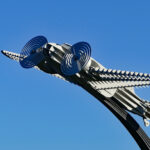Faced with mounting pressures from a protracted US-China trade war, China unveiled an important package of measures to boost its economy.
The sudden flurry in policy actions comes as Beijing and Washington confirm plans to hold high-level talks on trade later this week. This is a possible sign that the situation may deescalate.
The governor of People’s Bank of China, among other top Chinese officials in the financial sector, detailed a number of measures designed to support the growth and inject liquidity.
The key measures are the reduction of interest rates, and the reduction of banks’ reserve requirements. This will free up significant funds to be used for lending.
PBOC Governor Pan Gongsheng has announced a cut of 0.25 points in the lending rate by the PBOC to commercial banks. This brings it down to 1.5%.
Importantly, the reserve ratio required by banks has been lowered to 0.5%.
This measure, according to Governor Pan, would free up “1 trillion yuan (137.6 billion dollars) of extra cash for the banking sector.”
The central bank also reduced the interest rate on housing loans for five years, in an effort to help the property market, which is under pressure.
The government has also committed to increasing funding for technological innovations, factory upgrades and businesses in the service sector, such as elder care.
Trade wars: How to navigate the headwinds
The domestic measures of support are clearly a response to the economic damage caused by high tariffs levied by US President Donald Trump.
These trade barriers have further stressed China’s economy that is heavily dependent on exports. It already struggles with an extended downturn in the crucial real estate market.
These economic boosts were announced at the same time as news of the resumption of high-level trading talks.
Later this week, Treasury Secretary Scott Bessent, US Trade Representative Jamieson Grer, and Chinese Vice Premier He Lifeng are expected to meet in Geneva, Switzerland.
It will be the very first official dialogue after the recent round of tariff increases.
Cautious optimism greets dialogue
Although the two sides’ agreement to speak offers some hope, they have both maintained firm positions on their tariffs, leading to cautious reactions from the market.
Stephen Innes, SPI Asset Management, warned in a recent report that the talks “could serve as a pivotal point to either lock in fragile confidence, or reignite the trade war inferno.” This was emphasized by the stakes.
Recent data on the economy shows that both countries are under pressure.
The US economy shrank by 0.3% during the first quarter 2025.
China’s 5.4% growth was attributed to factories increasing production in response to a spike in pre-tariff orders. However, recent economic indicators indicate deteriorating business conditions and new export orders.
The financial markets have reacted to both the news that talks are underway and the announcement of a stimulus package with positive but restrained reactions. They had been in limbo from the trade standoff, in which the US imposed tariffs on Chinese products as high as 155% and the Chinese responded by raising their own rates up to 125%.
In early trading on Wednesday, Hong Kong’s share prices rose by over 2%. Shanghai also gained 0.5%, while US futures were up.
Market watchers expect a long-term resolution. Tan Jing Yi, Mizuho Bank’s Tan Jing Yi was quoted as saying: “We don’t expect a euphoric reaction.”
In the short term, it is possible that certain products may receive partial exemptions from tariffs, or even be exempted altogether.
Beijing is trying to manage the economic challenges created by an ongoing trade war through a combination of both domestic stimuli and re-opened dialogue.
As new information becomes available, this post Rate reductions and reserve ratio slashed to boost economy: China takes action ahead of US discussions may be updated.
This site is for entertainment only. Click here to read more






